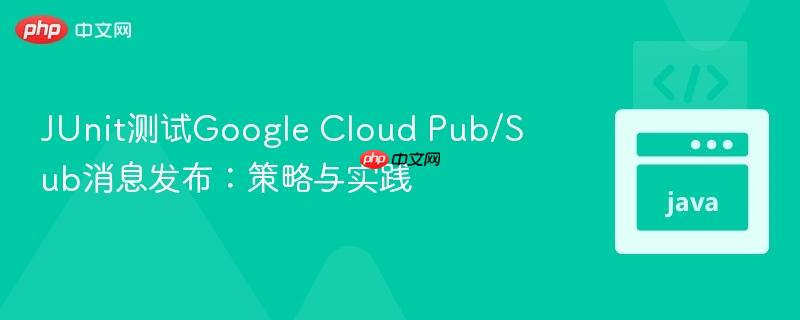
本文旨在探讨如何为google cloud pub/sub消息发布功能编写有效的junit测试。由于`publisher.builder`等核心类在设计上不易直接模拟,导致单元测试面临挑战。文章将介绍通过引入抽象接口进行代码重构,从而实现依赖解耦和可测试性增强的策略,并提供详细的junit测试示例,帮助开发者构建健壮的pub/sub发布服务。
在现代云原生应用中,消息队列如Google Cloud Pub/Sub扮演着至关重要的角色。然而,当我们需要为发布消息到Pub/Sub的代码编写单元测试时,可能会遇到一些挑战。核心问题在于Google Cloud Pub/Sub客户端库中的Publisher.Builder等类通常是final的,且其构建过程涉及复杂的内部逻辑和静态方法调用,这使得使用传统Mocking框架(如Mockito)直接模拟这些类变得困难。
考虑以下一个典型的Pub/Sub消息发布服务方法:
import com.google.api.core.ApiFuture;
import com.google.cloud.pubsub.v1.Publisher;
import com.google.protobuf.ByteString;
import com.google.pubsub.v1.PubsubMessage;
import com.google.pubsub.v1.TopicName;
import org.slf4j.Logger;
import org.slf4j.LoggerFactory;
import java.io.IOException;
import java.util.concurrent.ExecutionException;
import java.util.concurrent.TimeUnit;
public class PubSubPublisherService {
private static final Logger log = LoggerFactory.getLogger(PubSubPublisherService.class);
private final PubSubConfig config; // 假设这是一个包含projectId和topicId的配置类
public PubSubPublisherService(PubSubConfig config) {
this.config = config;
}
public String publishJSON(String json) throws InterruptedException, IOException, ExecutionException {
log.info(" Publishing payload to: " + config.getTopicId());
TopicName topicName = TopicName.of(config.getPubsubProjectId(), config.getTopicId());
Publisher publisher = null;
try {
publisher = Publisher.newBuilder(topicName).build();
ByteString data = ByteString.copyFromUtf8(json);
PubsubMessage pubsubMessage = PubsubMessage.newBuilder().setData(data).build();
ApiFuture<String> messageIdFuture = publisher.publish(pubsubMessage);
String messageId = messageIdFuture.get();
log.info("Published message ID: " + messageId);
return messageId;
} catch (ExecutionException e) {
log.error("Error while publishing message: " + e.getMessage(), e);
throw e;
} catch (IOException e) {
log.error("PubSub exception: " + e.getMessage(), e);
throw e;
} catch (InterruptedException e) {
log.error("Connection making exception for PubSub: " + e.getMessage(), e);
throw e;
} catch (Exception e) {
log.error("publishJSON Error: " + e.getMessage(), e);
throw e;
} finally {
if (publisher != null) {
publisher.shutdown();
publisher.awaitTermination(1, TimeUnit.MINUTES);
}
}
}
}
// 假设的PubSubConfig类
class PubSubConfig {
private String pubsubProjectId;
private String topicId;
public PubSubConfig(String pubsubProjectId, String topicId) {
this.pubsubProjectId = pubsubProjectId;
this.topicId = topicId;
}
public String getPubsubProjectId() { return pubsubProjectId; }
public String getTopicId() { return topicId; }
}这段代码直接在publishJSON方法内部创建了Publisher实例。这意味着Publisher.newBuilder()是一个静态工厂方法,并且返回的Publisher对象及其相关方法可能难以直接模拟。为了实现有效的单元测试,我们需要将外部依赖(这里是Pub/Sub客户端库的具体实现)与业务逻辑解耦。
最佳实践是通过引入一个抽象层来封装对外部服务的调用。这通常意味着定义一个接口,然后提供一个实现类来包装具体的Pub/Sub客户端库逻辑。我们的业务服务将依赖于这个接口,而不是具体的实现。
首先,定义一个描述Pub/Sub发布行为的接口:
import java.io.IOException;
import java.util.concurrent.ExecutionException;
public interface MessagePublisher {
String publish(String messagePayload) throws InterruptedException, IOException, ExecutionException;
}然后,创建一个实现类,将原有的publishJSON逻辑封装起来:
import com.google.api.core.ApiFuture;
import com.google.cloud.pubsub.v1.Publisher;
import com.google.protobuf.ByteString;
import com.google.pubsub.v1.PubsubMessage;
import com.google.pubsub.v1.TopicName;
import org.slf4j.Logger;
import org.slf4j.LoggerFactory;
import java.io.IOException;
import java.util.concurrent.ExecutionException;
import java.util.concurrent.TimeUnit;
public class GoogleCloudPubSubPublisher implements MessagePublisher {
private static final Logger log = LoggerFactory.getLogger(GoogleCloudPubSubPublisher.class);
private final PubSubConfig config;
public GoogleCloudPubSubPublisher(PubSubConfig config) {
this.config = config;
}
@Override
public String publish(String messagePayload) throws InterruptedException, IOException, ExecutionException {
log.info(" Publishing payload to topic: " + config.getTopicId());
TopicName topicName = TopicName.of(config.getPubsubProjectId(), config.getTopicId());
Publisher publisher = null;
try {
publisher = Publisher.newBuilder(topicName).build();
ByteString data = ByteString.copyFromUtf8(messagePayload);
PubsubMessage pubsubMessage = PubsubMessage.newBuilder().setData(data).build();
ApiFuture<String> messageIdFuture = publisher.publish(pubsubMessage);
String messageId = messageIdFuture.get();
log.info("Published message ID: " + messageId);
return messageId;
} catch (ExecutionException e) {
log.error("Error while publishing message: " + e.getMessage(), e);
throw e;
} catch (IOException e) {
log.error("PubSub exception: " + e.getMessage(), e);
throw e;
} catch (InterruptedException e) {
log.error("Connection making exception for PubSub: " + e.getMessage(), e);
throw e;
} finally {
if (publisher != null) {
publisher.shutdown();
publisher.awaitTermination(1, TimeUnit.MINUTES);
}
}
}
}现在,如果我们的应用中有一个服务需要使用这个发布功能,它将通过依赖注入的方式获取MessagePublisher接口的实例:
// 假设这是使用Pub/Sub发布消息的业务服务
public class MyBusinessService {
private final MessagePublisher messagePublisher;
public MyBusinessService(MessagePublisher messagePublisher) {
this.messagePublisher = messagePublisher;
}
public String processAndPublish(String data) throws InterruptedException, IOException, ExecutionException {
// 可以在这里进行一些业务逻辑处理
String processedData = "Processed: " + data;
return messagePublisher.publish(processedData);
}
}有了抽象接口后,我们可以轻松地使用Mockito来模拟MessagePublisher接口,从而在单元测试中隔离对Pub/Sub的实际调用。
import org.junit.jupiter.api.BeforeEach;
import org.junit.jupiter.api.Test;
import org.mockito.InjectMocks;
import org.mockito.Mock;
import org.mockito.MockitoAnnotations;
import java.io.IOException;
import java.util.concurrent.ExecutionException;
import static org.junit.jupiter.api.Assertions.*;
import static org.mockito.ArgumentMatchers.anyString;
import static org.mockito.Mockito.*;
class MyBusinessServiceTest {
@Mock
private MessagePublisher mockMessagePublisher; // 模拟MessagePublisher接口
@InjectMocks
private MyBusinessService myBusinessService; // 注入mock对象到MyBusinessService
@BeforeEach
void setUp() {
MockitoAnnotations.openMocks(this); // 初始化Mock对象
}
@Test
void testProcessAndPublish_Success() throws InterruptedException, IOException, ExecutionException {
String testData = "test payload";
String expectedMessageId = "mock-message-id-123";
// 当mockMessagePublisher的publish方法被调用时,返回预设的messageId
when(mockMessagePublisher.publish(anyString())).thenReturn(expectedMessageId);
String actualMessageId = myBusinessService.processAndPublish(testData);
// 验证publish方法被调用了一次,且参数匹配
verify(mockMessagePublisher, times(1)).publish("Processed: " + testData);
assertEquals(expectedMessageId, actualMessageId);
}
@Test
void testProcessAndPublish_PublishThrowsException() throws InterruptedException, IOException, ExecutionException {
String testData = "error payload";
// 当mockMessagePublisher的publish方法被调用时,抛出异常
when(mockMessagePublisher.publish(anyString())).thenThrow(new ExecutionException("Mock Pub/Sub error", null));
// 验证方法是否抛出了预期的异常
ExecutionException thrown = assertThrows(ExecutionException.class, () -> {
myBusinessService.processAndPublish(testData);
});
// 验证异常信息
assertTrue(thrown.getMessage().contains("Mock Pub/Sub error"));
// 验证publish方法被调用了一次
verify(mockMessagePublisher, times(1)).publish("Processed: " + testData);
}
}通过这种方式,我们可以在不实际连接Pub/Sub或创建真实Publisher实例的情况下,对MyBusinessService的业务逻辑进行全面的单元测试。
通过引入一个简单的接口层,我们成功地将业务逻辑与具体的Pub/Sub客户端实现解耦,从而极大地简化了单元测试的编写。这种模式是处理任何外部服务依赖的通用且推荐的做法,它提升了代码的灵活性、可测试性和可维护性。
以上就是JUnit测试Google Cloud Pub/Sub消息发布:策略与实践的详细内容,更多请关注php中文网其它相关文章!

每个人都需要一台速度更快、更稳定的 PC。随着时间的推移,垃圾文件、旧注册表数据和不必要的后台进程会占用资源并降低性能。幸运的是,许多工具可以让 Windows 保持平稳运行。

Copyright 2014-2025 https://www.php.cn/ All Rights Reserved | php.cn | 湘ICP备2023035733号